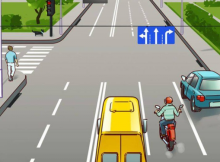Do you love challenging your attention to detail? If so, this picture puzzle is perfect for you! It invites you to examine an ordinary street scene—complete with traffic signs, cars, and pedestrians—where something just doesn’t seem right. It might look like a typical street at first glance, but a closer look reveals a subtle mistake. Ready to put your observation skills to the test? Let’s dive in!

Analyzing the Scene: The Street Puzzle
The image presents what seems like a normal street, with lanes, traffic signs, cars, and pedestrians. But remember, this puzzle is designed to trick you. There’s an error lurking somewhere, so you’ll need to take a closer look at the finer details.
Step 1: Focus on the Road Markings and Signs
First, let’s start by analyzing the road markings and traffic signs. At a glance, everything appears to be in order. There are three lanes with arrows indicating the directions each lane allows:
- The left lane has a left-turn arrow.
- The middle lane has a straight-ahead arrow.
- The right lane has a right-turn arrow.
These markings and signs seem typical for a busy street. But this is where the puzzle gets interesting—take a closer look at the far-right lane.
Step 2: Spotting the Right-Turn Lane Issue
Now, focus your attention on the right-turn lane and its corresponding traffic sign. The sign clearly indicates that vehicles in this lane can make a right turn. But hold on! If you follow the direction of the right-turn arrow, you’ll notice that it doesn’t lead to an actual street.
Instead, the arrow points toward a curb and some greenery. In other words, the road layout doesn’t accommodate the right turn suggested by the sign. So, while the sign indicates that turning right is an option, there’s no actual road for cars to follow through. This misleading right-turn sign creates the inconsistency that’s at the core of this puzzle.
Common Mistakes When Solving Visual Puzzles
Even the most observant individuals can struggle with these types of puzzles. So, what are some of the common pitfalls that make spotting these errors challenging?
1. Focusing Solely on Main Elements
Our brains are naturally drawn to the most prominent parts of an image. In this case, it’s the vehicles, the pedestrians, and the bold traffic signs. However, the error lies not in these central elements but in the interaction between the sign and the layout of the road. The key to solving this puzzle is paying attention to how these elements work together—or, in this case, don’t work together.
2. Overlooking Background Details
The background often hides the most telling clues. While most people concentrate on the cars or the pedestrians, the road’s layout and markings are equally important. In this puzzle, the discrepancy is in the way the road and the signs align—or fail to align—creating the confusion.
3. Making Assumptions Based on Logic
Our brains tend to make logical assumptions, especially with familiar scenes like streets. We expect to see a road where a right-turn sign suggests one exists. But in this puzzle, that assumption leads us astray. The puzzle deliberately plays on this tendency, making it difficult to spot the error unless you challenge your assumptions.
Breaking Down the Solution: Identifying the Mistake
The solution to this puzzle lies in identifying the misleading right-turn sign. Here’s a step-by-step breakdown:
- Look closely at the right-most lane’s arrow, which points toward the curb.
- Observe the lack of a road for the right turn. Despite the sign indicating that a right turn is possible, there’s no actual lane or street to accommodate it.
- Identify the contradiction: The sign suggests an action (turning right) that isn’t possible, making the sign itself the error.
The absence of a corresponding road for the right-turn arrow is the puzzle’s hidden mistake. It’s a small detail, but it throws off the logical flow of the street, making it the subtle error in this image.
How to Improve Your Observation Skills
If you struggled with this puzzle, don’t worry—there are ways to sharpen your observational skills. Here are a few tips:
1. Practice Regularly
The more you practice spotting differences, the better you’ll become at noticing subtle details. Whether through similar puzzles or real-life situations, actively engage your attention to detail.

2. Slow Down
Take your time when analyzing images or scenes. Rushing can cause you to miss crucial details, like the missing road in this puzzle.
3. Change Your Perspective
Sometimes, looking at a puzzle from a different angle or distance can help reveal hidden details. Don’t be afraid to adjust your perspective and rethink your assumptions.
Conclusion: Did You Spot the Mistake?
Did you manage to spot the missing road on your own? If so, well done! If not, don’t feel discouraged—this puzzle was designed to be tricky. It’s a fantastic reminder that details matter, and things aren’t always as they seem. Next time you come across a spot-the-difference puzzle, remember to slow down, question what you see, and enjoy the challenge. After all, puzzles like this one are more than just games; they’re a fun way to improve how you see the world around you.

